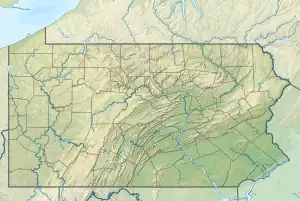| Kelly Run Tributary to Sewickley Creek | |
|---|---|
 Location of Kelly Run mouth  Kelly Run (Sewickley Creek tributary) (the United States) | |
| Location | |
| Country | United States |
| State | Pennsylvania |
| County | Westmoreland |
| Physical characteristics | |
| Source | Little Sewickley Creek divide |
| • location | about 0.5 miles south of Herminie, Pennsylvania[1] |
| • coordinates | 40°14′59″N 079°42′30″W / 40.24972°N 79.70833°W[2] |
| • elevation | 1,175 ft (358 m)[1] |
| Mouth | Sewickley Creek |
• location | Hutchinson, Pennsylvania[3] |
• coordinates | 40°13′30″N 079°44′42″W / 40.22500°N 79.74500°W[2] |
• elevation | 798 ft (243 m)[3] |
| Length | 2.83 mi (4.55 km)[4] |
| Basin size | 1.88 square miles (4.9 km2)[5] |
| Discharge | |
| • location | Sewickley Creek |
| • average | 2.26 cu ft/s (0.064 m3/s) at mouth with Sewickley Creek[5] |
| Basin features | |
| Progression | Sewickley Creek → Youghiogheny River → Monongahela River → Ohio River → Mississippi River → Gulf of Mexico |
| River system | Monongahela River |
| Tributaries | |
| • left | unnamed tributaries |
| • right | unnamed tributaries |
| Bridges | Balentine Road, Herminie-West Newton Road, Apples Mill Road |
Kelly Run is a 2.83 mi (4.55 km) long 1st order tributary to Sewickley Creek in Westmoreland County, Pennsylvania.
Course
Kelly Run rises about 0.5 miles south of Herminie, Pennsylvania,[1] and then flows southwest to join Sewickley Creek at Hutchinson.[3]
Watershed
Kelly Run drains 1.88 square miles (4.9 km2) of area, receives about an average of 1,016.30 millimetres (40.012 in) of precipitation each year, has a wetness index of 373.55, and is about 26% forested.[5]
See also
References
- 1 2 3 "Get Maps". USGS Topoview. US Geological Survey. Retrieved 16 November 2020.
- 1 2 "GNIS Detail - Kelly Run". geonames.usgs.gov. US Geological Survey. Retrieved 16 November 2020.
- 1 2 3 "Get Maps". USGS Topoview. US Geological Survey. Retrieved 16 November 2020.
- ↑ "ArcGIS Web Application". epa.maps.arcgis.com. US EPA. Retrieved 16 November 2020.
- 1 2 3 "Kelly Run Watershed Report". US EPA Geoviewer. US EPA. Retrieved 16 November 2020.
This article is issued from Wikipedia. The text is licensed under Creative Commons - Attribution - Sharealike. Additional terms may apply for the media files.